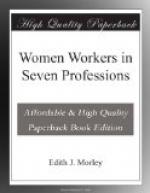The aim of the Fabian Women’s Group was to elicit women’s own thoughts and feelings on their economic position, and to this end we invited women of experience and expert knowledge, from various quarters and of many types of thought, to discourse of what they best knew to audiences of women. After the lectures, the questions raised were discussed in all their bearings by women speaking amongst women without diffidence or prejudice. In this manner the physical disabilities of women as workers have been explained clearly by women doctors, and carefully and frankly weighed and considered; the part taken by women in producing the wealth of this country in past times has been set forth by students of economic history, and much scattered material of great value unearthed, and for the first time brought together concerning a subject hitherto deemed negligible by the male historian. Lastly, women employed in or closely connected with each leading occupation or group of occupations to-day—from the professions to the sweated industries—are being asked to describe and to discuss with us the economic conditions they have directly experienced or observed.[1]
It is hoped in time to complete and shape for publication all the material accumulated during these six years. We make a beginning with this book of essays on the economic position of women in seven of the leading professions at present open to them. Some of the papers appear almost in the form in which they were first read to the group and its women visitors: when the original lectures did not fully cover the ground, they have been revised, altered, expanded, or re-written, or essays by new writers have been substituted for those originally presented. Thus the papers on “Teaching in Secondary Schools” by Dr O’Brien Harris and that on “Teaching in Elementary Schools” by Mrs Dice, take the place of an address on “The Life of a Teacher,” by Miss Drummond, President of the Incorporated Association of Assistant Mistresses. This paper was withdrawn at the writer’s request, but many valuable points from her lecture, which she generously placed at the disposal of the Editor, have been embodied. The other papers in the Education Section are all new. Similarly, in the section which deals with the profession of Nursing, Miss Hughes’ paper on “District-Nursing” is the only one which is based on a lecture given to the group; the other articles are all supplementary. Together, we believe they form a unique and almost exhaustive description of the profession.
That the volume might be made as useful as possible, the same method has been followed throughout. The paper and discussion at the group meeting have formed the nucleus from which a thorough treatment of the subject has been developed.
We hope and believe that this book may help to arouse deeper interest in the vigour and energy with which professional women are now striving to make good their economic position; that it may serve to enlist active sympathy with their struggle against the special difficulties and hindrances which beset them, and make plain the value to society of the work they can do. We also believe that the information here brought together may be useful in helping young women to choose and prepare for their life-work.




